#Navajo code talkers
Text
I saw this on quora and thought it was cool and wanted to share it on here. Its a long read but crazy. Its from Erik Painter

They did try. And they did capture Navajo men. However, they were unsuccessful in using them to decipher the code. The reason was simple. The Navajo Code was a code that used Navajo. It was not spoken Navajo. To a Navajo speaker, who had not learned the code, a Navajo Code talker sending a message sounds like a string of unconnected Navajo words with no grammar. It was incomprehensible. So, when the Japanese captured a Navajo man named Joe Kieyoomia in the Philippines, he could not really help them even though they tortured him. It was nonsense to him.
The Navajo Code had to be learned and memorized. It was designed to transmit a word by word or letter by letter exact English message. They did not just chat in Navajo. That could have been understood by a Navajo speaker, but more importantly translation is never, ever exact. It would not transmit precise messages. There were about 400 words in the Code.
The first 31 Navajo Marines created the Code with the help of one non-Navajo speaker officer who knew cryptography. The first part of the Code was made to transmit English letters. For each English letter there were three (or sometimes just two) English words that started with that letter and then they were translated into Navajo words. In this way English words could be spelled out with a substitution code. The alternate words were randomly switched around. So, for English B there were the Navajo words for Badger, Bear and Barrel. In Navajo that is: nahashchʼidí, shash, and tóshjeeh. Or the letter A was Red Ant, Axe, or Apple. In Navajo that is: wóláchííʼ, tsénił , or bilasáana. The English letter D was: bįįh=deer, and łééchąąʼí =dog, and chʼįįdii= bad spiritual substance (devil).
For the letter substitution part of the Code the word “bad” could be spelled out a number of ways. To a regular Navajo speaker it would sound like: “Bear, Apple, Dog”. Or other times it could be “ Barrel, Red Ant, Bad Spirit (devil)”. Other times it could be “Badger, Axe, Deer”. As you can see, for just this short English word, “bad” there are many possibilities and to the combination of words used. To a Navajo speaker, all versions are nonsense. It gets worse for a Navajo speaker because normal Navajo conjugates in complex ways (ways an English or Japanese speaker would never dream of). These lists of words have no indicators of how they are connected. It is utterly non-grammatical.
Then to speed it up, and make it even harder to break, they substituted Navajo words for common military words that were often used in short military messages. None were just translations. A few you could figure out. For example, a Lieutenant was “one silver bar” in Navajo. A Major was “Gold Oak Leaf” n Navajo. Other things were less obvious like a Battleship was the word for Whale in Navajo. A Mine Sweeper was the Navajo word for Beaver.
A note here as it seems hard for some people to get this. Navajo is a modern and living language. There are, and were, perfectly useful Navajo words for submarines and battleships and tanks. They did not “make up words because they had no words for modern things”. This is an incorrect story that gets around in the media. There had been Navajo in the military before WWII. The Navajo language is different and perhaps more flexible than English. It is easy to generate new words. They borrow very few words and have words for any modern thing you can imagine. The words for telephone, or train, or nuclear power are all made from Navajo stem roots.
Because the Navajo Marines had memorized the Code there was no code book to capture. There was no machine to capture either. They could transmit it over open radio waves. They could decode it in a few minutes as opposed to the 30 minutes to two hours that other code systems at the time took. And, no Navajo speaker who had not learned the Code could make any sense out of it.
The Japanese had no published texts on Navajo. There was no internationally available description of the language. The Germans had not studied it at the time. The Japanese did suspect it was Navajo. Linguists thought it was in the Athabaskan language family. That would be pretty clear to a linguist. And Navajo had the biggest group of speakers of any Athabaskan language. That is why they tortured Joe Kieyoomia. But, he could not make sense of it. It was just a list of words with no grammar and no meaning.
For Japanese, even writing the language down from the radio broadcasts would be very hard. It has lots of sounds that are not in Japanese or in English. It is hard to tell where some words end or start because the glottal stop is a common consonant. Frequency analysis would have been hard because they did not use a single word for each letter. And some words stood for words instead of for a letter. The task of breaking it was very hard.
Here is an example of a coded message:
béésh łigai naaki joogii gini dibé tsénił áchį́į́h bee ąą ńdítį́hí joogi béésh łóó’ dóó łóóʼtsoh
When translated directly from Navajo into English it is:
“SILVER TWO BLUE JAY CHICKEN HAWK SHEEP AXE NOSE KEY BLUE JAY IRON FISH AND WHALE. “
You can see why a Navajo who did not know the Code would not be able to do much with that. The message above means: “CAPTAIN, THE DIVE BOMBER SANK THE SUBMARINE AND BATTLESHIP.”
“Two silver bars” =captain. Blue jay= the. Chicken hawk= dive bomber. Iron fish = sub. Whale= battleship. “Sheep, Axe Nose Key”=sank. The only normal use of a Navajo word is the word for “and” which is “dóó ”. For the same message the word “sank” would be spelled out another way on a different day. For example, it could be: “snake, apple, needle, kettle”.
Here, below on the video, is a verbal example of how the code sounded. The code sent below sounded to a Navajo speaker who did not know the Code like this: “sheep eyes nose deer destroy tea mouse turkey onion sick horse 362 bear”. To a trained Code Talker, he would write down: “Send demolition team to hill 362 B”. The Navajo Marine Coder Talker then would give it to someone to take the message to the proper person. It only takes a minute or so to code and decode.
youtube
31K notes
·
View notes
Text

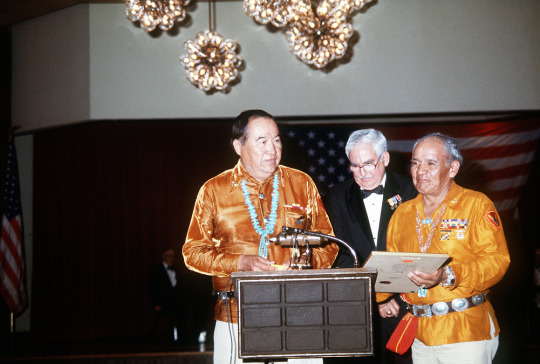
President of the Navajo Code Talkers, left, Joe Garza; ceremony chairman, center, and the vice-president of the Code Talkers present a copy of the Navajo Code Talkers Marine Corps hymn, on February 20, 1988.
Record Group 330: Records of the Office of the Secretary of Defense
Series: Combined Military Service Digital Photographic Files
Image description: Three men standing at a podium. Two of the men are wearing orange uniform shirts with military decorations, khaki pants, and silver and turquoise necklaces and belts. One holds a plaque. The third man is wearing a black jacket with medals, white shirt, and black bow tie. In the background is an American flag.
Image description: Uncropped version of previous photo, with large distracting light fixture or decoration above the three men.
#archivesgov#February 20#1988#1980s#Navajo Code Talkers#USMC#U.S. Marine Corps#military#Native American history#American Indian history#Indigenous American history#Navajo#World War II#WWII
82 notes
·
View notes
Text
Who Were the Navajo Code Talkers?
During World War II, the act of sending messages which could not be intercepted was becoming a more and more difficult task thanks to the advent of new technologies. As a result, code began to be used more and more prevalently.
This is where the Navajo Code Talkers, also known as Diné code talkers, come in. Comprised of U.S. Marines that descended from at least 14 Native nations, they used their indigenous languages to develop special codes which allowed for communication across the Pacific front from 1942 to 1945. Not once during those three years was the code ever cracked.

These individuals and their knowledge of indigenous language proved a great asset to the U.S. military. An incredibly ironic fact as many of them had been forced to attend government or religious-run American Indian Residential Schools. Schools which actively sought to force Native American children into assimilation, in part by discouraging indigenous languages.
Learn More: National WWI Museum, United Service Organizations, Naval History and Heritage Command
#Native American Indian Heritage Month#WWII#World War II#Navajo Code Talkers#Diné Code Talkers#Military History#Code
11 notes
·
View notes
Photo

Forty years ago, President Ronald Reagan designated August 14th as Navajo Code Talkers Day in honor of the services contributed by the Navajo Code Talkers during World War II.
Navajo is a spoken language handed down orally from generation to generation. The Code talkers created a system of native words to represent characters of the English alphabet, so that they could spell out English words with no Navajo equivalent. They also assigned their own expressions, like iron-fish to mean submarine, for over 400 important military terms. Their codes were never cracked by the enemy.
This Navajo Code Talker G.I. Joe can say seven phrases in both Navajo and English, and also came with a list of 200 phrases used by the Navajo Code Talkers.
17 notes
·
View notes
Text
#code beautiful code#code talking#encryption#secrets#navajo#navajo code talkers#cherokee#comanche#unbroken codes
2 notes
·
View notes
Text
"Sam always said, 'I wanted my Navajo youngsters to learn, they need to know what we did and how this code was used and how it contributed to the world,'" she said Saturday. "That the Navajo language was powerful and always to continue carrying our legacy."
7 notes
·
View notes
Text
The Spirit of Valor: Contributions of Navajo Code Talkers and Women During World War II
During World War II, the United States military faced a major challenge in communication security. The Axis powers were skilled at intercepting and decoding messages, thus compromising the security of American operations. In order to counter this threat, the military began recruiting Navajo Code Talkers, who used their unwritten Navajo language to transmit messages that were almost impossible for…
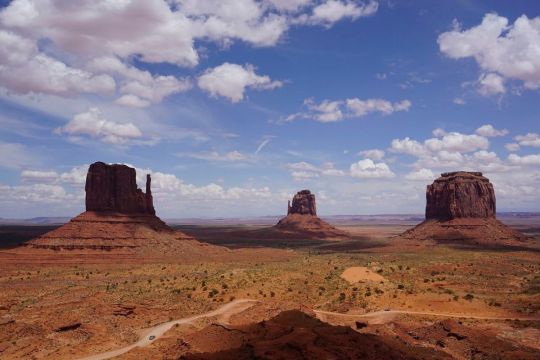
View On WordPress
#history#literature#native american#navajo#navajo code speakers#navajo code talkers#rosie the riveter#war#war history#war industry#wartime#world war ii#world war two
1 note
·
View note
Text
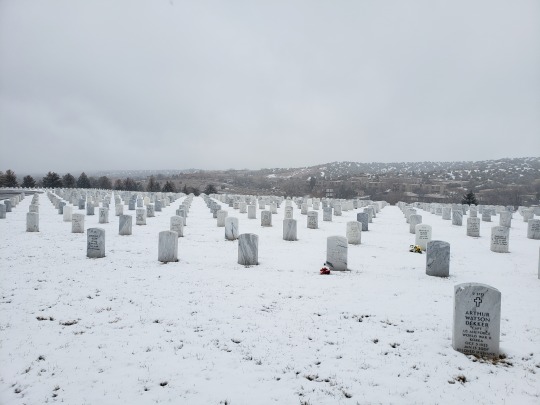
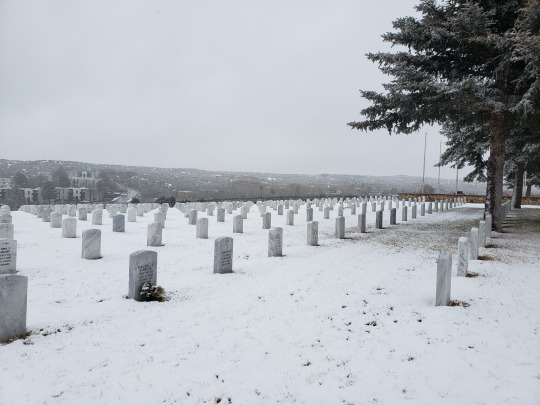
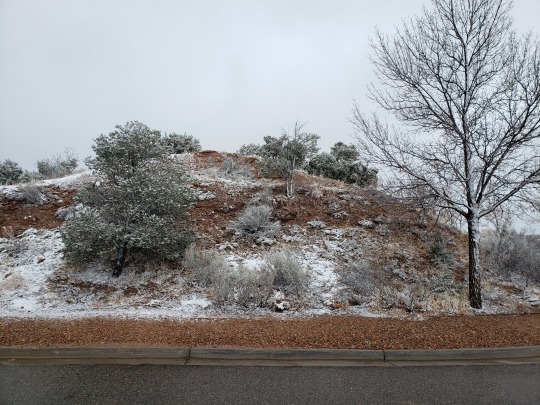
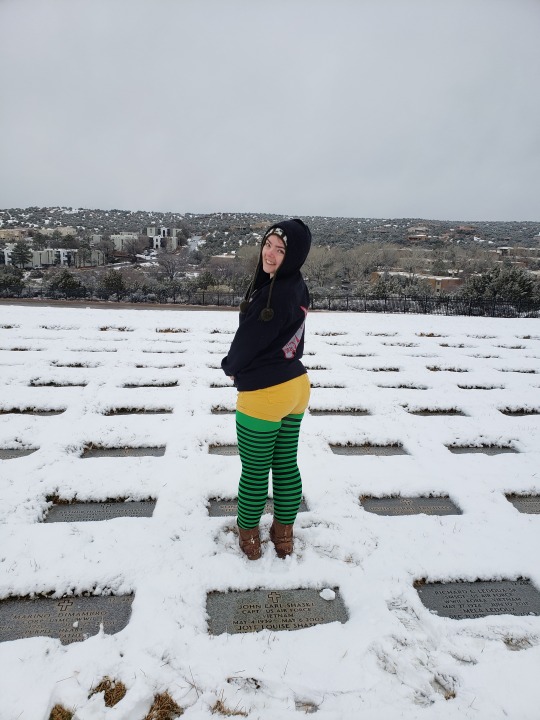
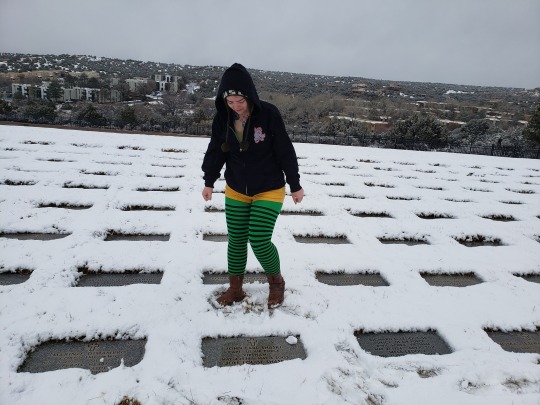

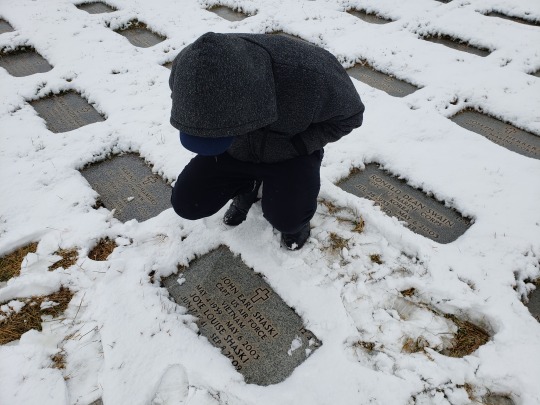
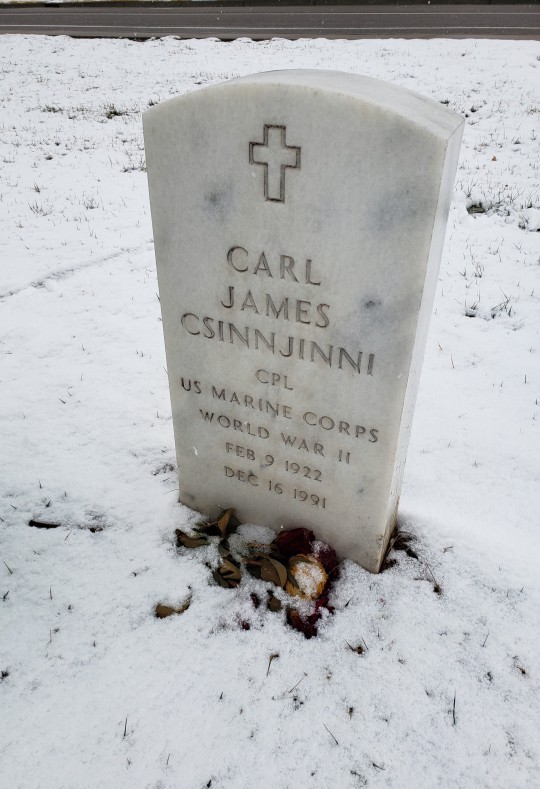

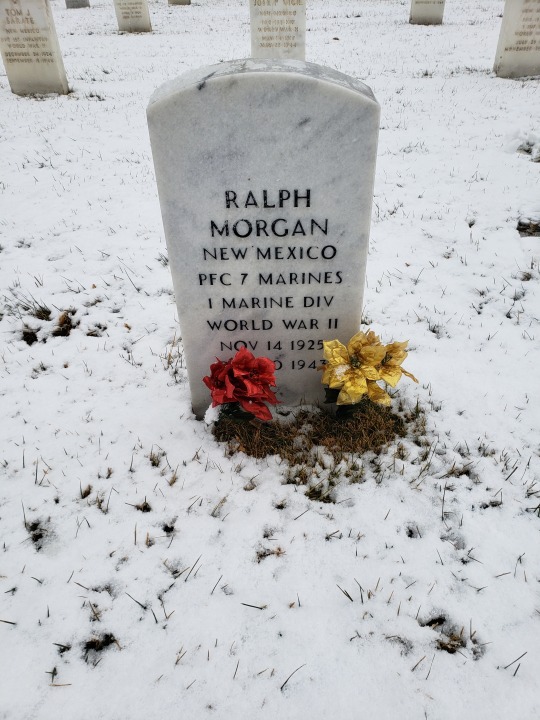


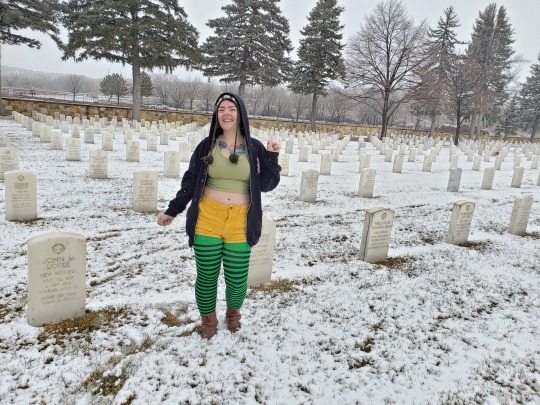
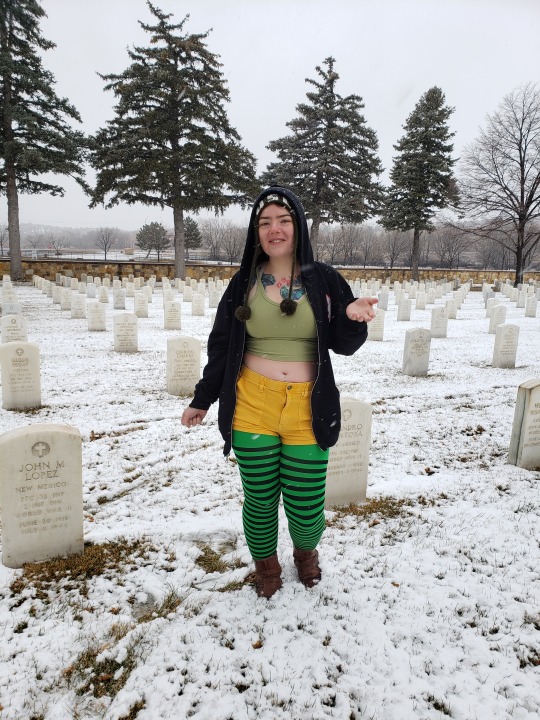
Shayne never got to meet my grandparents, and I had never visited their gravesite. I figured today was the day to drive 67 miles north and rectify the situation, and what magical intuition I must possess because it SNOWED on the way up.
Do you know what I love more than a graveyard in the snow? Not much.
John and Joye Shaski are buried in a national cemetery for veterans, in which every grave is numbered and neat as a pin. The only variation between sites is in the stones themselves, how aged they are, how marbled, and whether they stand up or lie down. As a lover of systematic organization, it is beautiful to behold.
There are a lot of people buried here. Of the 29 Navajo Code Talkers, 14 of them reside at Santa Fe National Cemetery, just a few lots away from my grandparents. There are also a lot of people memorialized here that are decorated and honored for their roles in slaughtering Native Americans and defending slavery in the U.S. American South. It's a painful dissonance that I try to release as I look out at the quietly falling snow.
We couldn't visit all of the Code Talkers (the cemetery is huge!) but we wanted to pay our respects to a few.
Carl James Csinnjinni, Sam Morgan, and Ralph Morgan. I'm no fan of the military industrial complex, but you guys fought Nazis under the banner of a country that wiped out your people and you have nothing but my respect. I'm so glad visitors still cover your resting places with flowers.
Shayne knelt down and thanked John and Joye for their role in my existence 🥹. They would've loved him.
My grandma would've scoffed at my outfit (if you haven't worn a crop top in 34 degree wet snowfall, are you even from New England?) and most of my life choices, but my grandpa would've just been happy I was there. I miss them both.
I showed them my hoodie from their Alma Mater, the same college I graduated from this year. The logo is from their era in the 60s so I'm sure they recognize it.
I love a graveyard in the snow.
#graveyard#ancestry#snow#santa fe#military#navajo code talkers#veteran#i thought veteran and veterinarian was the same thing for a long time#me#my love#family
1 note
·
View note
Text
Today is Navajo (or, more correctly, Diné) Code Talker Day in the United States, so here's a short piece to mark the occasion.

133 notes
·
View notes
Link
43 notes
·
View notes
Text
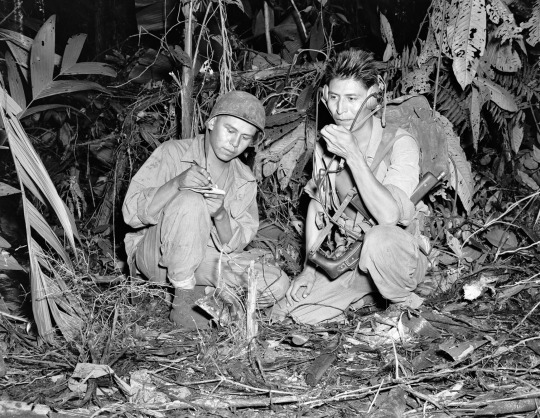
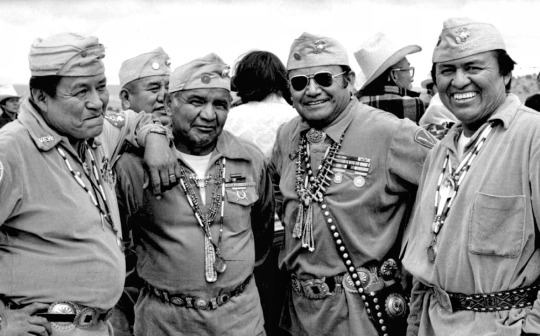

August 14th is National Navajo Code Talkers Day.
We celebrate and honor the contributions of Native Americans / First Nations people who contributed to helping turn the tide, in favor of the Allies, during World War II. These true American heroes and warriors shall never be forgotten!
Semper Fi! 🦅🌎⚓️
#usmc#us marines#navajo#code talker#native american#heroes#warriors#wwii#world war 2#military#history#never forgotten
309 notes
·
View notes
Text

USMC Native American Code Talkers on Bougainville, Dec 1943. (L-R front): Pvt Earl Johnny, Pvt Kee Etsicitty, Pvt John V. Goodluck, and PFC David Jordan. L-R Rear Pvt Jack C. Morgan, Pvt George H. Kirk, Pvt Tom H. Jones, Cpl Henry Bahe, Jr.

Navajo code talkers Corporal Henry Bahe Jr. and Private First Class George H. Kirk. Bougainville, South Pacific, December 1943.
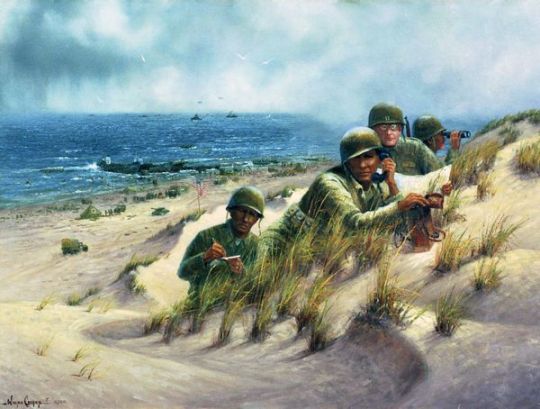
Wayne Cooper, Indian Code Talkers, 2000. Oil on canvas. - The painting depicts code talker Charles Chibitty (Comanche) after landing at Utah Beach during World War II.
During World Wars I and II, hundreds of Native American servicemen from more than twenty tribes used their Indigenous languages to send secret, coded messages enemies could never break. Known as code talkers, these men helped U.S. forces achieve military victory in some of the greatest battles of the twentieth century.

Pfc. Preston Toledo and Pfc. Frank Toledo, Navajo cousins in a Marine artillery regiment in the South Pacific, relay orders over a field radio in their native tongue.
They were present at many important battles, including at Utah Beach during the D-Day invasion in France, and at Iwo Jima in the Pacific. In fact, 5th Marine Division signal officer Major Howard Connor stated, “Were it not for the Navajos, the Marines would never have taken Iwo Jima.”
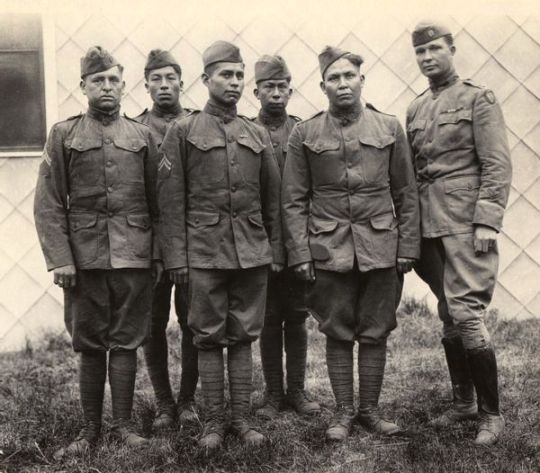
Choctaw telephone squad, returned from fighting in World War I. Camp Merritt, New Jersey, June 7, 1919. From left: Corporal Solomon Bond Louis, Private Mitchell Bobb, Corporal James Edwards, Corporal Calvin Wilson, Private Joseph (James) Davenport, Captain Elijah W. Horner.

Meskwaki code talkers, February 1941. Top, left to right: Judie Wayne Wabaunasee, Melvin Twin, Dewey Roberts Sr., Mike Wayne Wabaunasee; Bottom: Edward Benson, Frank Jonas Sanache Sr., Willard Sanache, Dewey Youngbear.
The men were assigned to the 168th Infantry, 34th Red Bull Division and were sent to North Africa, where they participated in the attacks on Italy under heavy shelling. Three of the men were captured and confined to Italian and German prison camps.
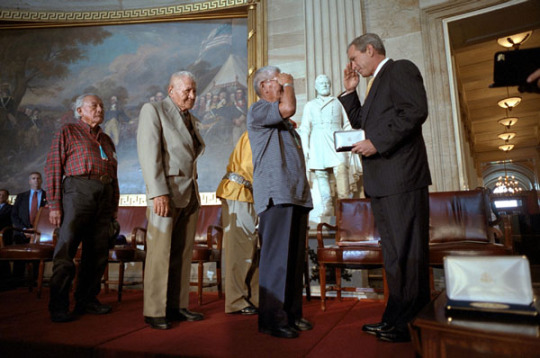
President George W. Bush presented the Congressional Gold Medal to Navajo code talkers on July 26, 2001. (White House Photo Office)

Navajo code talkers photographed in 2005 at Monument Valley, Utah.
#Code Talkers#indigenous usmc#indigenous#photography#historical photos#bw#vintage photography#painting#Navajo#comanche#choctaw#cliff clavin
7 notes
·
View notes
Photo

Samuel Sandoval
71 notes
·
View notes
Photo
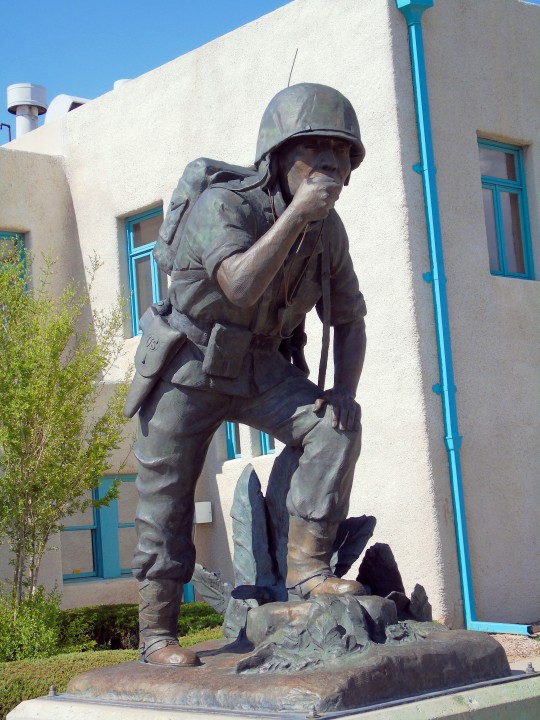
National Navajo Code Talkers Day
Navajo Code Talkers Day, celebrated every year on August 14, is a day that holds great importance in the history of the U.S. This is because the day recognizes the contributions of Native American soldiers during World War II. Yes, Native American soldiers encoded and transmitted messages using a complex Navajo language-based code during a time when secret communication was essential to win a war. And guess what? The code was never broken by Japanese forces in the Pacific and proved to be of great assistance to the U.S. Marines. On this day, celebrate the great American heroes and their service to the nation!
History of Navajo Code Talkers Day
The C.I.A.’s official site has stated that Navajo was a near ‘perfect’ language that was used to create military codes. This is why it has been recorded in history and is recognized for its brilliance even today. However, the code wasn’t the language itself but was a communication form that was encrypted using the Navajo language. Since many people couldn’t decipher it, the code remained unbreakable throughout the war. It is this success of the code that is celebrated by Americans every year. National Navajo Code Talkers Day was made a legal state holiday in 2020 by Governor Doug Ducey who signed legislation to honor the courage of the Navajo Code Talkers and their critical role in the WWII victory. According to him, the Navajo Code Talkers are “American heroes.”
It all started in 1942 when the U.S. was fighting World War II in the Pacific and needed an unbreakable code to ensure the success of military operations. During this time, Philip Johnston, the son of a missionary who had grown up in the Navajo Nation, suggested a code be created using the Navajo language. After this, there was no turning back and the U.S. government recruited over 400 Navajo men to serve during the war. The Navajo Code Talkers successfully transmitted more than 800 messages without error and helped the U.S. win the war. Hence, in 1982, Navajo Code Talkers Day was established through a presidential proclamation by President Ronald Reagan In 2014, Arizona passed legislation declaring every August 14 Navajo Code Talkers Day in Arizona.
Here’s a little more on one of the Navajo Code creators Samuel Billison. The man enlisted in the United States Marine Corps in 1943 and was a popular code talker. He also served as president of the Navajo Code Talkers Association.
Navajo Code Talkers Day timeline
1942 Top Secret
Philip Johnston, a World War I veteran, discovers that the military is experimenting with codes.
1968 Round of Applause
The Navajo Code Talkers receive the first public recognition at the 4th Marine Division reunion.
1992 The Special Honor
The Navajo Code Talkers are honored at the Pentagon.
2001 The Gold
President George W. Bush presents the 29 original Navajo Code Talkers with the Congressional Gold Medal.
How to Observe Navajo Code Talkers Day
Create a code of your own
Watch a documentary on WWII
Read up on the Navajo Code
To have some fun and also realize how tough it is to develop an unbreakable code, try to make one of your own and use it with your friends.
To find out more about the war and why the efforts of each and every citizen are still applauded, watch a historic documentary.
What is the Navajo Code? How was it created and what were the words used?You can find out everything you need to know with just a little research.
5 Interesting Facts You Need To Know About The Navajo Code
Never broken
Terms created
The code
First deployment
Another Navajo cannot decipher the code
It’s the only oral code in history that has never been broken.
The original twenty-nine men created 211 terms.
Navajo bird names were used and applied to weapons of war.
The Navajo Code Talkers were first deployed to the Battle of Guadalcanal.
Deciphering the code is not possible unless the Navajo is a code talker.
Why Navajo Code Talkers Day is Important
It promotes the Navajo heritage
It recognizes the efforts of the soldiers
It keeps history alive
The day is important since it promotes Navajo heritage, and also explains how different cultures and languages can prove to be beneficial in times of need.
During the war, the efforts of every soldier were essential for the survival of the state. This day recognizes the bravery and intelligence that was used to create the unbreakable Navajo code.
The day keeps alive the history of the war and the efforts of several communities who aided the United States in reaching success.
Source
#National Navajo Code Talkers Day#Navajo Code Talker#Gallup#New Mexico#summer 2014#sculpture#public art#Native American history#vacation#USA#travel#original photography#tourist attraction#landmark#cityscape#Southwestern USA#14 August#NationalNavajoCodeTalkersDay#WWII#World War Two#World War II
7 notes
·
View notes
Text
08/14/2023 is Engineers Day 🇩🇴, Partition Horrors Remembrance Day 🇮🇳, Pramuka Day 🇮🇩, Lizard Day 🦎🌏, Obon 👻🇯🇵, National Creamsicle Day 🇺🇲, National Navajo Code Talkers Day 🇺🇲, Falklands Day 🇬🇧
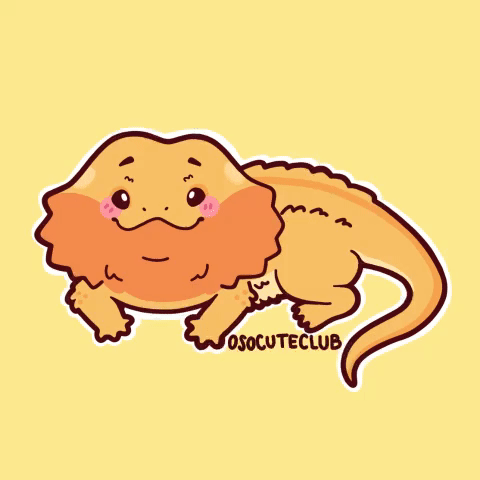
#engineers day#partition horrors remembrance day#pramuka day#lizard day#obon#national creamsicle day#national navajo code talkers day#falklands day
2 notes
·
View notes
Text
The few, the brave...
The few, the brave…
I met a couple of these heroes when I lived in Chinle in the Navajo Nation. Modest, kind, dedicated to fighting for a better world for us all.

View On WordPress
1 note
·
View note